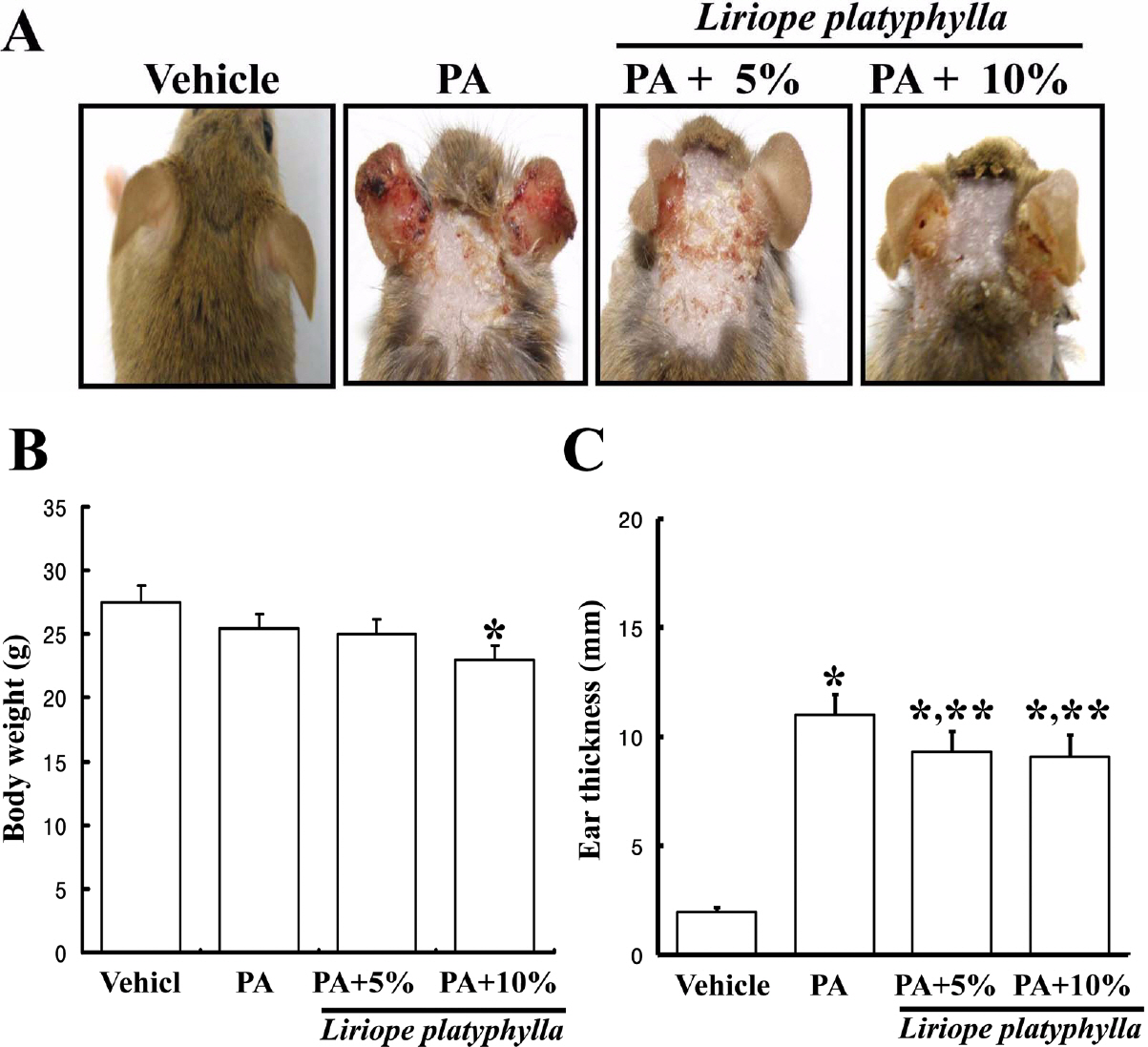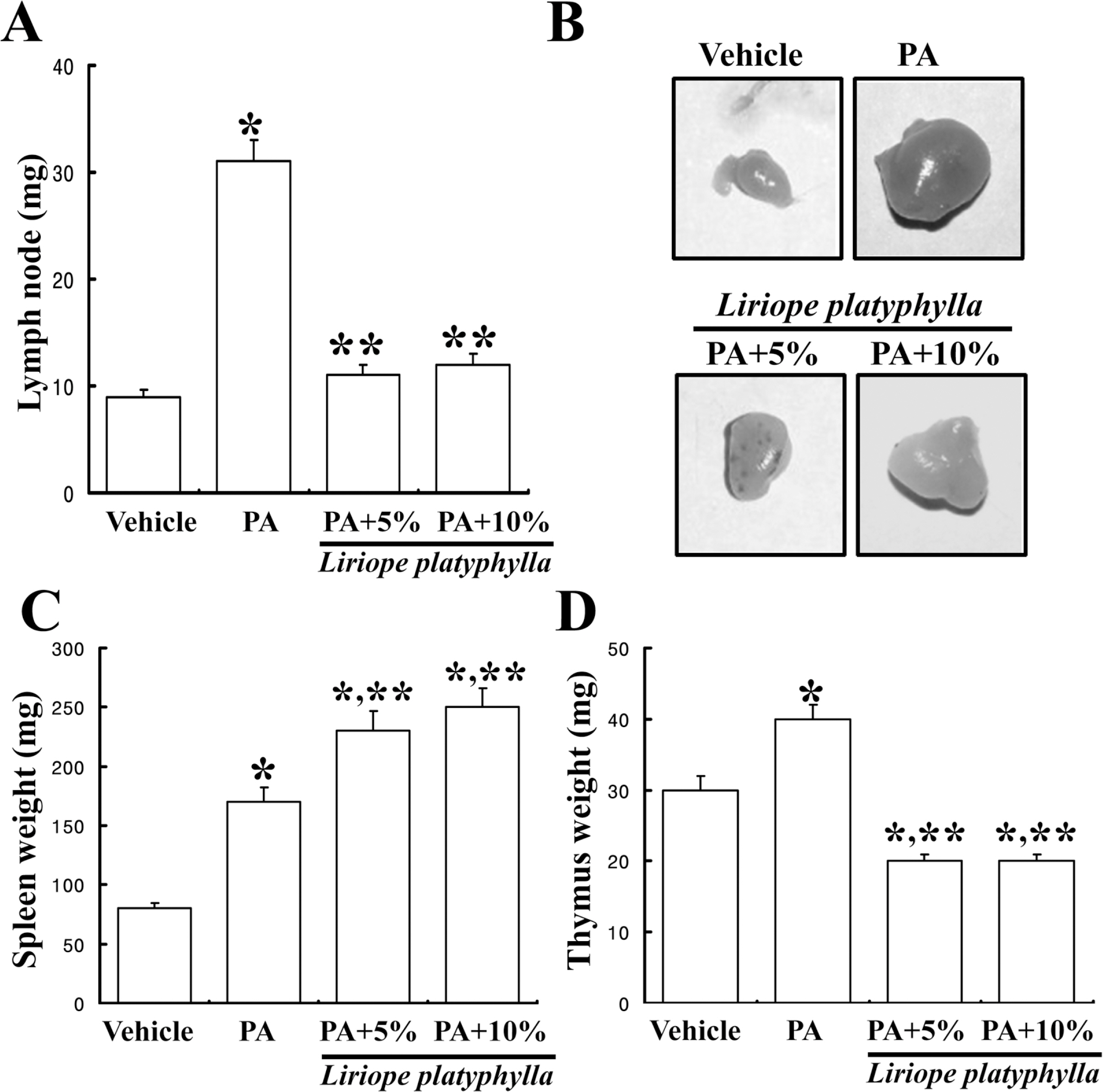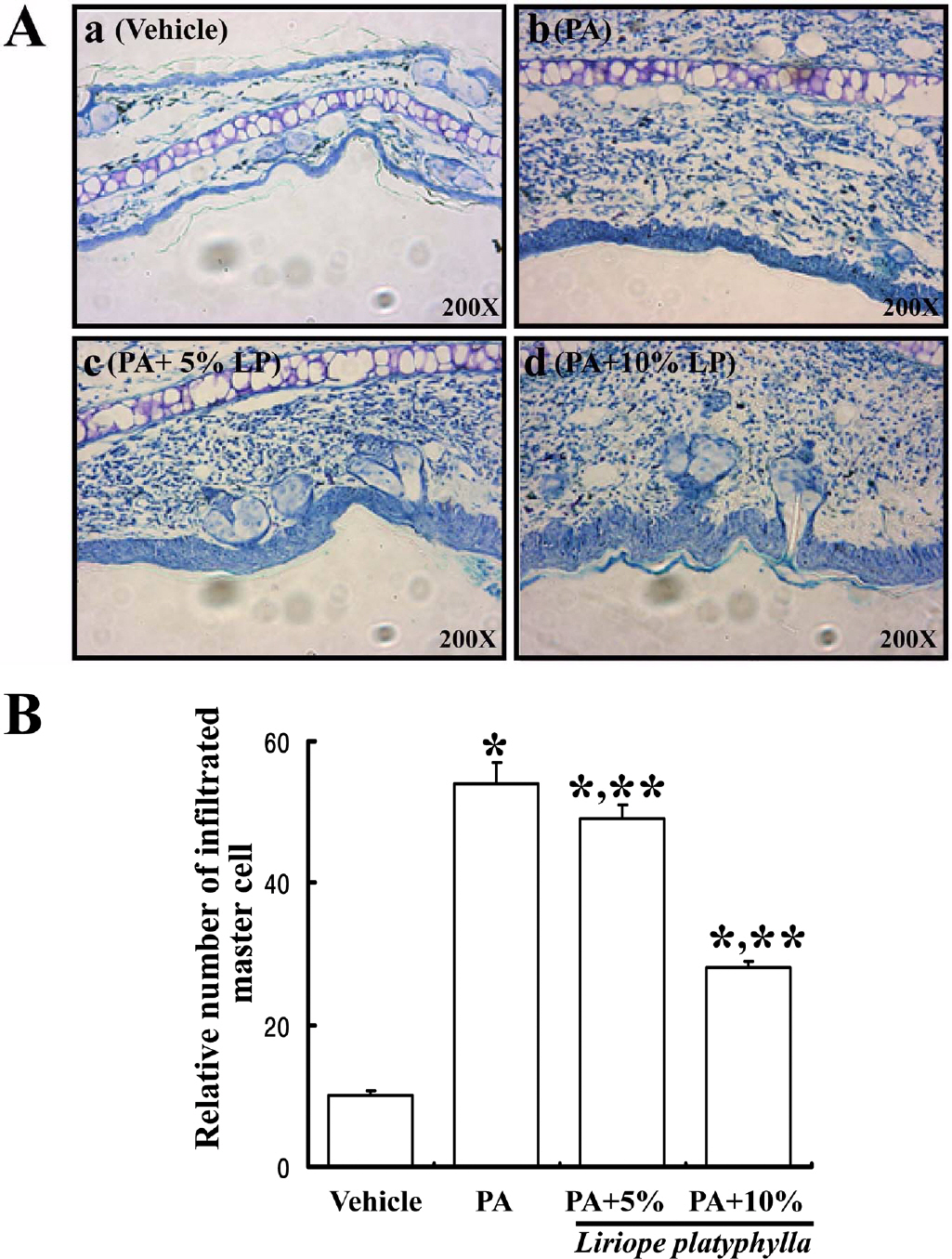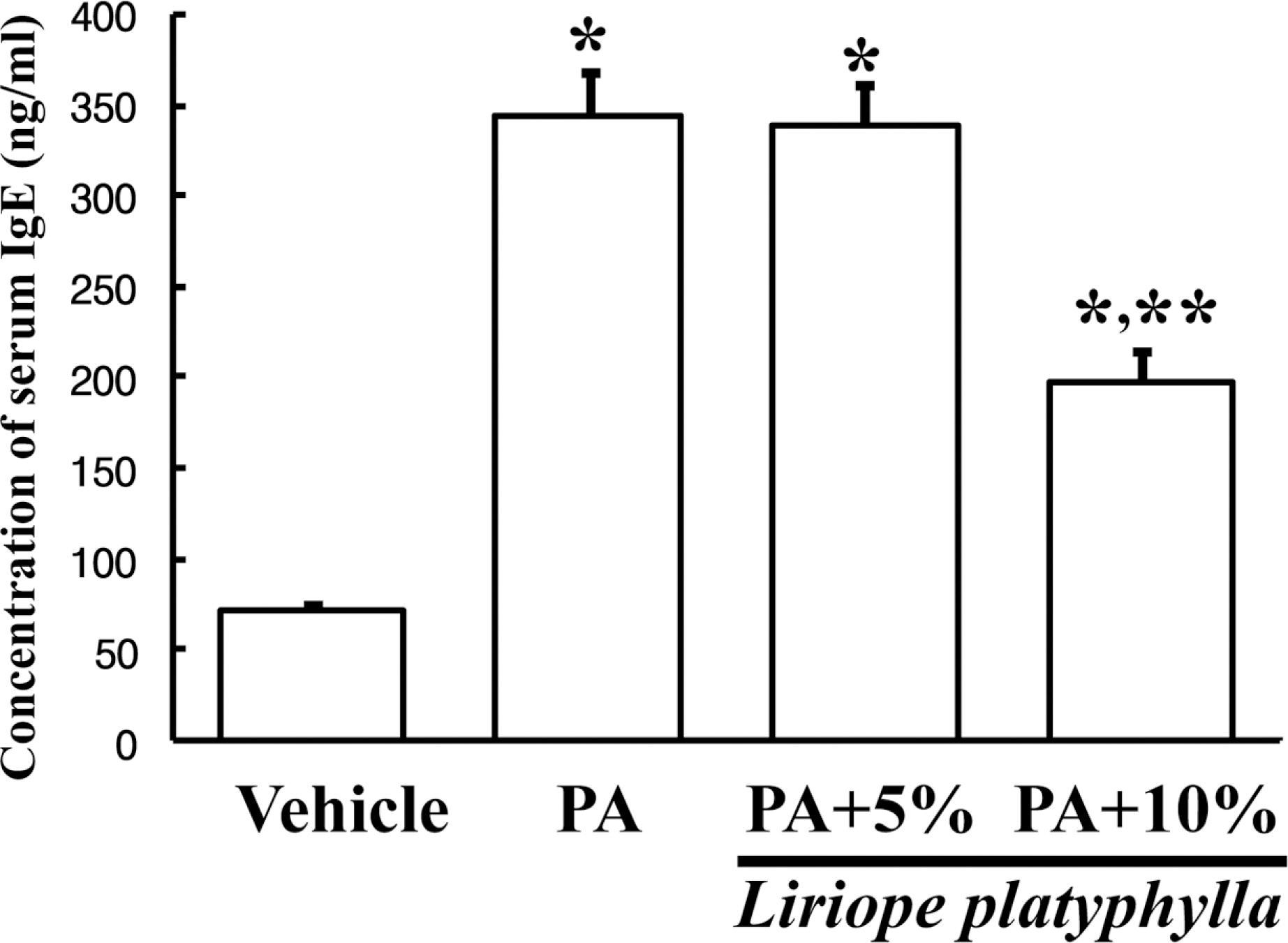Lab Anim Res.
2010 Dec;26(4):377-384. 10.5625/lar.2010.26.4.377.
The Symptoms of Atopic Dermatitis in NC/Nga Mice Were Significantly Relieved by the Water Extract of Liriope platyphylla
- Affiliations
-
- 1College of Natural Resources & Life Science, Pusan National University/PNU-Laboratory Animal Resources Center, Miryang, Korea.dyhwang@pusan.ac.kr
- 2Pusan National University-Wellbeing Products Center, Miryang, Korea.
- 3College of Human Ecology, Pusan National University, Pusan, Korea.
- KMID: 2114706
- DOI: http://doi.org/10.5625/lar.2010.26.4.377
Abstract
- Atopic dermatitis is an well-known skin disease showing inflammatory, chronically relapsing, non-contagious and pruritic symptoms. The aims of this study were to investigate the effects of Liriope platyphylla (LP) on atopic dermatitis of NC/Nga mice. To achieve this, NC/Nga mice were treated with four different conditions including vehicle, phthalic anhydride (PA), PA+5% LP and PA+10% LP, and the changes of immune-related factors were detected after 2 weeks. The pathological phenotypes of atopic dermatitis such as erythema, ear thickness, edema, scab and discharge were significantly decreased in PA+10% LP cotreated groups compare to PA treated group. Also, the weight of lymph node and thymus in immune organs were gradually decreased in LP treated groups, while the weight of spleen was slightly increased in same group. Furthermore, toluidine blue staining analysis, a method used to specifically identify the mast cell, showed that the decrease of master cell infiltration into the dermis were statistically observed in PA+5% LP and PA+10% LP5% cotreated groups. Especially, the decrease of IgE concentration was detected only PA+10% LP cotreated group, although this level was maintained in PA+5% LP cotreated group. Therefore, these results suggested that the water extracts of LP may contribute the relieve of atopic dermatitis symptoms and be considered as an excellent candidate for a atopic dermatitis-therapeutic drug.
Keyword
MeSH Terms
Figure
Reference
-
References
Bae, E.A., Han, M.J., Shin, Y.W. and Kim, D.H. (. 2006. ). Inhibitory effects of Korean red ginseng and its genuine constituents ginsenosides Rg3, Rf, and Rh2 in mouse passive cutaneous anaphylaxis reaction and contact dermatitis models. Biol. Pharm. Bull. 29(9):1862–1867.Ban, M. and Hettich, D. (. 2005. ). Effect of Th2 cytokine antagonist treatments on chemical-induced allergic response in mice. J. Appl. Toxicol. 25:239–247.Boehm, T. and Bleul, C.C. (. 2007. ). The evolutionary history of lymphoid organs. Nat. Immunol. 8(2):131–135.Choi, M.J., Lee, Y.M., Jin, B.S. and Kim, B.H. (. 2010. ). Inhibitory effect of Luteolin liposome solution by animal model for atopic dermatitis in NC/Nga mice. Lab. Anim. Res. 26(1):47–53.Choi, S.B., Wha, J.D. and Park, S. (. 2004. ). The insulin sensitizing effect of homoisoflavone-enriched fraction in Liriope platyphylla Wang et Tang via PI3-kinase pathway. Life Sci. 75:2653–2664.Dearman, R.J. and Kimber, I. (. 1992. ). Divergent immune responses to respiratory and contact chemical allergens: antibody elicited by phthalic anhydride and oxazolone. Clin. Exp. Allergy. 22:241–250.Dubois, G.R., BruijnzeeI-Koomen, C.A.F.M. and Bruijnzeel, P.L.B. (. 1994. ). IL-4-induced migration of eosinophils in allergic inflammation. Ann. N. Y. Acad. Sci. 725:268–273.Hur, J., Lee, P., Kim, J., Kim, A.J., Kim, H. and Kim, S.Y. (. 2004. ). Induction of nerve growth factor by butanol fraction of Liriope platyphylla in C6 and primary astrocyte cells. Biol. Pharm. Bull. 27:1257–1260.Hur, J., Lee, P., Moon, E., Kang, I., Kim, S.H., Oh, M.S. and Kim, S.Y. (. 2009. ). Neurite outgrowth induced by spicatoside A, a steroidal saponin, via the tyrosine kinase A receptor pathway. Eur. J. Pharmacol. 620:9–15.Incorvaia, C., Frati, F., Verna, N., D'Alo, S., Motolese, A. and Pucci, S. (. 2008. ). Allergy and the skin. Clin. Exp. Immunol. 153:27–29.Jeong, S., Chae, K., Jung, Y.S., Rho, Y.H., Lee, J., Ha, J., Yoon, K.H., Kim, G.C., Oh, K.S., Shin, S.S. and Yoon, M. (. 2008. ). The Korean traditional medicine Gyeongshingangjeehwan inhibits obesity through the regulation of leptin and PPARalpha action in OLETF rats. J. Ethnopharmacol. 119:245–251.Katon, W., Russo, J., Lin, E.H.B., Heckbert, S.R., Karter, A.J., Williams, L.H., Ciechanowski, P., Ludman, E. and Von Korff, M. (. 2009. ). Diabetes and poor disease control: is comorbid depression associated with poor medication adherence or lack of treatment intensification? Psychosom. Med. 71:965–972.Kay, A.B. (. 2001. ). Allergy and allergic diseases. N. Engl. J. Med. 344:30–37.Kim, H.J., Kim, J., Kim, S.J., Lee, S.H., Park, Y.S., Park, B.K., Kim, B.S., Kim, S.K., Cho, S.D., Jung, J.W., Nam, J.S., Choi, C.S. and Jung, J.Y. (. 2010. ). Anti-inflammatory effect of Quercetin on Picryl Chloride-induced contact dermatitis in BALB/c mice. Lab. Anim. Res. 26(1):7–13.Kim, S.D., Ku, Y.S., Lee, I.Z., Kim, I.D. and Youn, K.S. (. 2001. ). General components and sensory evaluation of hot water extract from Liriopis Tuber. J. Korean Soc. Food Sci. Nutr. 30(1):20–24.Kim, Y.H., Han, J.K. and Kim, Y.H. (. 2008a. ). Effect of Kami-kanghwalsan (KKHS) on atopic dermatitis-like skin lesions induced in NC/Nga mouse by mite antigen stimulation. J. Korean Oriental Pediatrics. 22(1):69–93.Kim, Y.H., Lee, S.Y. and Kim, W.I. (. 2008b. ). Antiallergic effects of Cheonmaectang in RBL-2H3 cell. J. Korean Oriental Pediatrics. 22(1):95–102.Kiwamoto, T., Ishii, Y., Morishima, Y., Yoh, K. and Maeda, A. (. 2006. ). Transcription factors T-bet and GATA-3 regulate development of airway remodeling. Am. J. Respir. Crit. Care Med. 174:142–151.Krentz, A.J., Patel, M.B. and Bailey, C.J. (. 2008. ). New drugs for type 2 diabetes mellitus: what is their place in therapy? Drugs. 68:2131–2162.Lee, Y.C., Lee, J.C., Seo, Y.B. and Kook, Y.B. (. 2005. ). Liriopis tuber inhibit OVA-induced airway inflammation and bronchial hyperresponsiveness in murine model of asthma. J. Ethnopharmacol. 101(1–3):144–152.Mebius, R.E. and Kraal, G. (. 2005. ). Structure and function of the spleen. Nat. Rev. Immunol. 5(8):606–16.Pabst, R. (. 2007. ). Plasticity and heterogeneity of lymphoid organs. What are the criteria to call a lymphoid organ primary, secondary or tertiary? Immunol. Lett. 112(1):1–8.Swirski, F.K., Nahrendorf, M., Etzrodt, M., Wildgruber, M., Cortez-Retamozo, V., Panizzi, P., Figueiredo, J.L., Kohler, R.H., Chudnovskiy, A., Waterman, P., Aikawa, E., Mempel, T.R., Libby, P., Weissleder, R. and Pittet, M.J. (. 2009. ). Identification of splenic reservoir monocytes and their deployment to inflammatory sites. Science. 325:612–616.Umetsu, D.T. and Dekruyff, R.H. (. 2006. ). The regulation of allergy and asthma. Immunol. Rev. 212:238–255.
- Full Text Links
- Actions
-
Cited
- CITED
-
- Close
- Share
- Similar articles
-
- Developing an Atopic Dermatitis Model and the Effects of Actinidia Extract on Dermatitis in NC/Nga Mice
- A Novel Model for Human Atopic Dermatitis: Application of Repeated DNCB Patch in BALB/c Mice, in Comparison with NC/Nga Mice
- Anti-inflammatory and Anti-pruritic Effects of Portulaca oleracea L. Extract Using In Vitro and In Vivo Inflammation Model: LPS-treated Raw264.7 Cells, Keratinocytes, NC/Nga Mice and Hairless SKH-1 Mice
- Therapeutic Effects of Light Emitting Diode on Atopic Dermatitis-Like Lesions in NC/Nga Mice
- A Study on Tests of Skin Safety and Inhibition of Atopic Dermatitis Using a StoneTouch(R) Infrared Scanner in a Mouse Model






